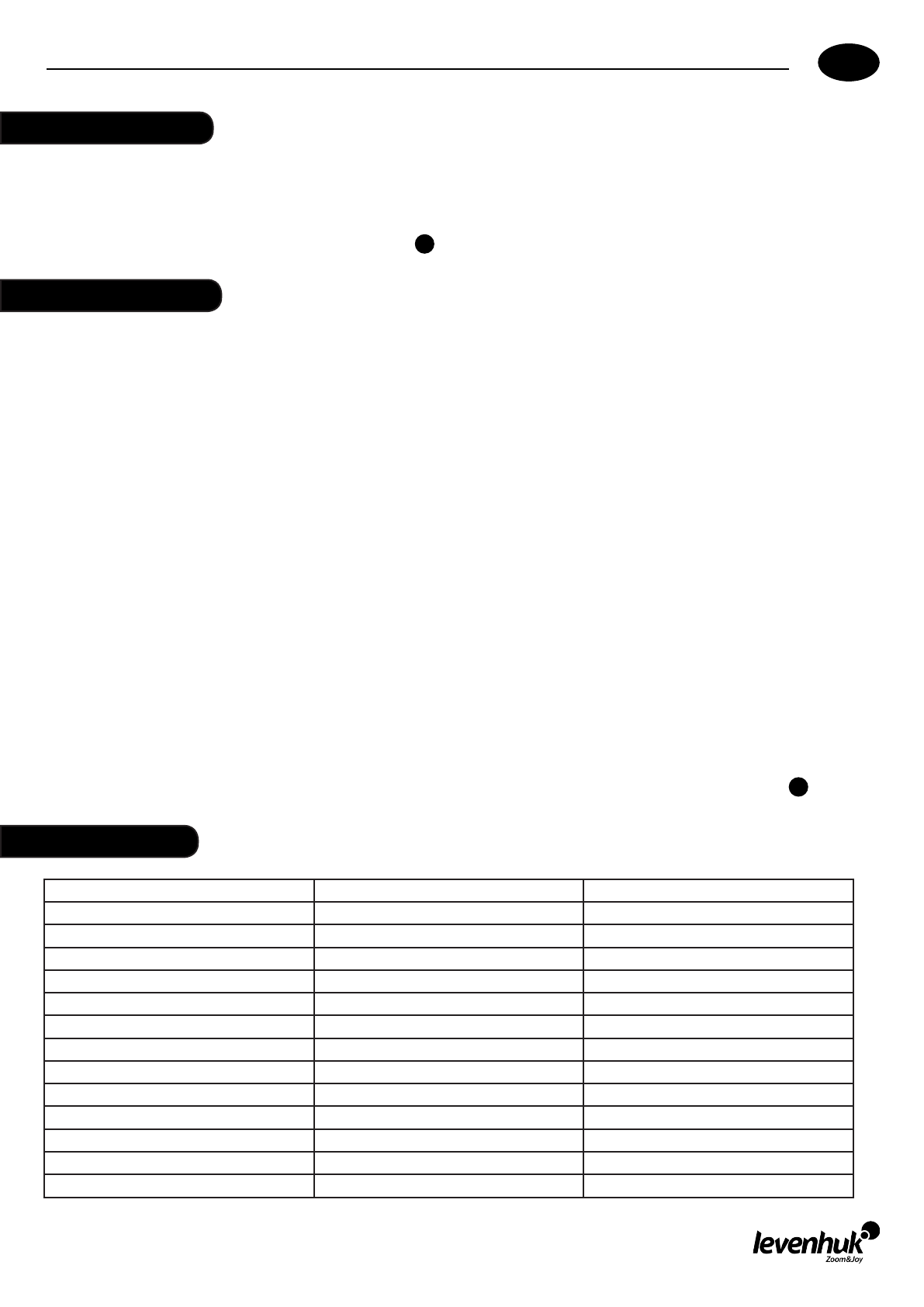Телескопы Levenhuk Strike 100 PLUS - инструкция пользователя по применению, эксплуатации и установке на русском языке. Мы надеемся, она поможет вам решить возникшие у вас вопросы при эксплуатации техники.
Если остались вопросы, задайте их в комментариях после инструкции.
"Загружаем инструкцию", означает, что нужно подождать пока файл загрузится и можно будет его читать онлайн. Некоторые инструкции очень большие и время их появления зависит от вашей скорости интернета.

7
EN
Levenhuk Strike PLUS Telescopes
EN
Dec. Balancing
1. Tighten the R.A. lock knob when the counterweight rod is horizontal to the ground.
2. While holding the telescope with one hand, loosen the Dec. lock knob with the other.
3. Loosen the telescope tube rings and slide the telescope forward or backward until it is balanced even when you release the
telescope tube. Tighten the tube rings the Dec. lock knob.
22
The equatorial mount allows for compensating the rotation of Earth around its axis and easily tracking celestial objects during
observations. To achieve this, the R.A. axis has to be aligned to the rotation axis of Earth. This process is known as polar
alignment.
Look north and find Polaris. As it is located within 1° of the rotation axis of Earth (North Celestial Pole), you will be aligning your
telescope to this star.
1. Loosen one of the adjustment screws and tighten the other until your latitude is shown on the latitude scale by the indicator
pin (while doing this the mount ascend or descend. You can look up the latitude of your location on a map.
2. Loosen the Dec. lock knob and rotate the telescope tube until it is parallel to the R.A. axis. Tighten the lock knob. Doing this
will make it easier to aim your telescope at Polaris.
3. Loosen the azimuth locking knob and rotate the mount until both the tube and the R.A. axis are pointed at Polaris. Retighten
the azimuth locking knob. If you cannot find Polaris, try pointing the telescope and the R.A. axis due north.
Upon doing this, no further adjustments in the azimuth and latitude of the mount should be made during the observing session,
nor should you move the tripod. Only movements in R.A. and Dec. axes should be made in order to keep the telescope aligned.
Now, to aim the telescope at an object (the Moon, Jupiter, Saturn, etc.) loosen the R.A. & Dec. lock knobs, point the telescope
tube toward the object, and retighten the lock knobs. Look at the object through the finder and aim the telescope precisely
with slow-motion controls. Make sure the red dot is pointing at the object. Start observing by using the 25mm eyepiece and
focus your view. To study the details of the Moon or planets, just follow this simple procedure.
1. With a low power eyepiece, make sure that the observed object is directly in the center of the eyepiece crosshairs.
2. Remove the eyepiece and replace it with a high power one. You can also use a Barlow lens to achieve maximum power. To do
that, first insert the Barlow lens in the focuser and then place an eyepiece into the receiving end of your Barlow lens.
23
Polar alignment
Levenhuk Strike 100 PLUS
Levenhuk Strike 120 PLUS
Optical design
Newtonian reflector
Newtonian reflector
Objective lens diameter (aperture), mm
102
114
Focal length, mm/in
640/25.1
700/27.5
Focal ratio
f/6.27
f/6.14
Highest practical power, x
160
186
Limiting stellar magnitude
12.1
12.4
Resolution threshold
1.14
1.02
Mount
Equatorial EQ1
Equatorial EQ1
Eyepieces diameter
1.25"
1.25"
Eyepieces
KF 25mm, Zoom 6.8-16mm
KF 25mm, Zoom 6.8-16mm
Finder scope
Red dot
Red dot
Tripod
steel
steel
Barlow lens
2x
2x
Specifications
Levenhuk Strike PLUS Telescopes
Содержание
- 30 ) Электронный искатель с красной точкой; Аксессуары; Телескопы Levenhuk Strike PLUS
- 31 ) Ручка тонких движений по оси склонения; Сборка
- 32 Модель; Использование линзы Барлоу; Балансировка трубы
- 33 Балансировка трубы по оси прямого восхождения; Установка полярной оси
- 34 Технические характеристики
- 35 пожизненная гарантия; Международная гарантия
- 44 оптическими приборами.; Засоби догляду за оптикою Levenhuk; оптичними пристроями.; Radost zaostřit













































